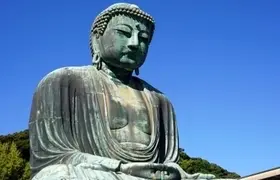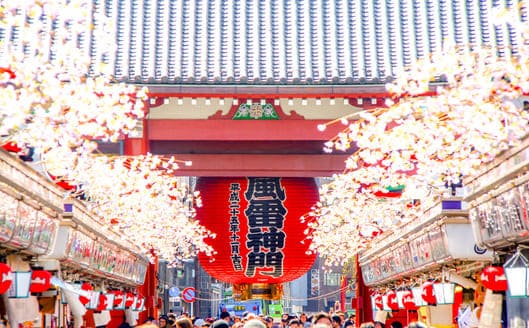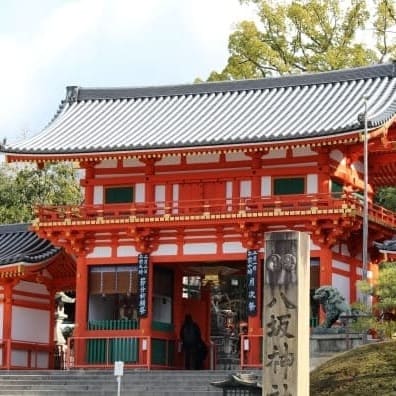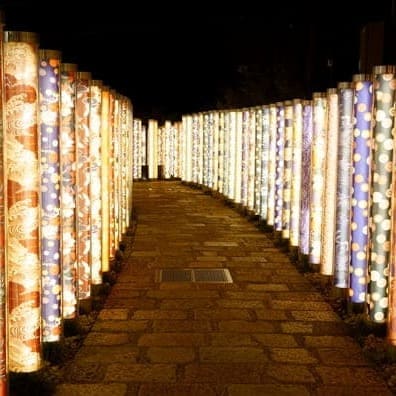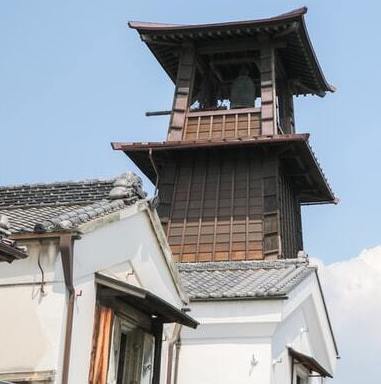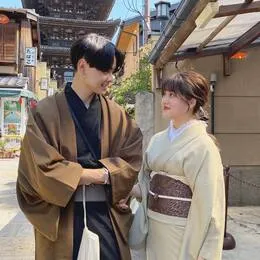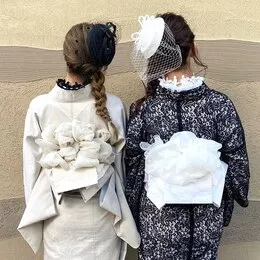Precautions when attending a wedding in official kimono

A wedding is a once-in-a-lifetime celebration. If you have been invited to a wedding, it’s important to express your gratitude and best wishes as soon as possible.
Next, it’s time to choose your attire for the wedding. If you’re unsure about what to wear, consider opting for a formal kimono called a “hōmongi.”
A hōmongi with auspicious or celebratory patterns is a perfect choice for a wedding outfit.
In this article, we will provide detailed guidance on what colors and patterns are suitable for a hōmongi when attending a wedding and what you should pay attention to.
You Can Attend Weddings in a Hōmongi
A hōmongi is a semi-formal kimono, following the furisode in terms of formality. It can be worn regardless of age or marital status.
With its elegant patterns painted throughout the garment, a hōmongi is indeed a suitable choice for the joyous occasion of a wedding ceremony.
For the difference between “Tsukeage” and “Hōmongi,” please refer to What is the Difference Between Tsukeage and Hōmongi?.
Relatives Should Choose a Formal Kimono
When relatives wear a hōmongi at a wedding, pairing it with a white half-collar, a formal obi, a white obi-age, and an obi-jime will create a formal and appropriate attire for the occasion.
It is recommended to choose white or light-colored zori sandals and a small-sized bag suitable for formal occasions.
At weddings, it’s common for the relatives of the bride and groom, especially if they are married, to wear black furisode with a design featuring five family crests (Gosan-mon).
This gesture of wearing the first formal kimono shows respect to the wedding guests. However, distant relatives may hesitate to wear furisode.
Additionally, unmarried sisters who have graduated from wearing furisode may find it challenging to select an outfit. In such cases, consider wearing a vibrant, all-over patterned hōmongi to add to the festive atmosphere.
Dress More Conservatively Than Relatives When Attending as Friends or Acquaintances
When attending a wedding as a friend or acquaintance, it’s advisable to choose attire that is less formal than what relatives wear. This demonstrates respect towards the bride, groom, and their families. The hōmongi, as a semi-formal kimono, is a fitting choice for a wedding.
For hōmongi attire as a friend or acquaintance, consider coordinating the obi-age and obi-jime colors with those of the kimono and obi for a harmonious and elegant appearance.
Guest of Honor Should Choose an Elegant Hōmongi
If you have been invited as the guest of honor at a wedding, aim for an elegant and dignified appearance in your hōmongi.
The guest of honor often has a deep connection to the bride and groom and may have the responsibility of delivering a speech during the reception, making them a prominent figure among the guests.
For the guest of honor’s hōmongi, it is recommended to choose patterns with auspicious symbols or classical motifs. Additionally, patterns that reflect the season are a great choice.
For example, in spring, consider patterns featuring cherry blossoms or peonies, while in autumn, patterns with maple leaves or chrysanthemums can add a seasonal touch to your stylish ensemble as the guest of honor.
Choosing Colors and Patterns for a Wedding Hōmongi
When attending a wedding, it’s important to choose attire that suits your role and position. We will explain how to select a lovely hōmongi that complements you from among the many color and pattern options.
Opt for Classical Patterns When Choosing a Hōmongi Pattern
For a hōmongi worn to a wedding, classical patterns are highly recommended.
Among classical patterns, those with auspicious motifs are ideal for weddings. You’ll find a wide range of auspicious patterns such as “Matsu Take Ume” (pine, bamboo, plum), “Shikunshi” (Four Gentlemen), “Botan Karakusa” (peony arabesque), “Noshi Me” (lucky knot), “Tsurukame” (crane and turtle), “Kaiaiawase” (seashell pairing), and “Ōgi” (fan).
Furthermore, traditional patterns like “Yūshoku Monyō” (patterns of the imperial court) or “Shōsōin Monyō” (patterns from the Shōsōin treasure house) can enhance the elegance of your hōmongi when used for the obi’s pattern.
Wearing a White-Based Hōmongi is Acceptable
It’s perfectly acceptable to wear a white-based hōmongi to a wedding.
Unlike Western clothing, where wearing white might overlap with the bride’s white wedding dress, hōmongi is a traditional Japanese garment with patterns such as Yuzen dyeing and embroidery on a white base. Therefore, there is no concern about resembling a wedding dress.
Black-Based Hōmongi Exudes Formality
A black-based hōmongi carries a strong sense of formality, especially when adorned with crests.
Even if you are a distant relative or recently married, having a black-based hōmongi with classical patterns on hand will allow you to confidently wear it to the wedding.
Emphasize Elegance with Pastel-Colored Hōmongi
Pastel colors create a soft and delicate impression.
When wearing a light yellow or pale blue hōmongi, consider tying the obi in a unique way to add a touch of elegance.
Pastel-colored hōmongi can enhance the festive atmosphere and add a sense of charm to the wedding.
To understand the differences between hōmongi and Iro-tomesode, please check 【Basic Knowledge】What Are the Differences Between Hōmongi and Iro-tomesode?.
Etiquette and Considerations When Wearing a Hōmongi
Hōmongi is a beautiful kimono with intricate patterns. Since it enhances the wearer’s appearance, it’s important to pay attention to etiquette.
Maintain Good Posture and Take Small Steps in a Hōmongi
When wearing a hōmongi, be sure to keep your chin up and maintain good posture.
Engage your core muscles to maintain an upright stance, and take small, graceful steps.
And when walking, take small steps. A good rule of thumb is to take about two-thirds of your usual stride when walking in Western clothing.
When wearing zori sandals, extend the front of the sandal straight ahead when walking. There’s no need to walk with your feet close together or in an awkward manner.
By taking smaller steps and extending the front of your zori sandals straight, you’ll achieve a slow and graceful walking style.
Entering and Exiting Vehicles in Hōmongi
When wearing hōmongi, be cautious when getting in and out of vehicles to avoid dirtying the hem.
When getting into a vehicle, sit down first. Lift the sleeves of your kimono and place them on your lap to prevent them from getting dirty.
Turn your body gently, align your feet, and enter the vehicle slowly.
When exiting, place your feet on the ground while holding up the hem, then stand up slowly.
Use Your Right Hand to Lift the Hem When Going Up or Down Stairs
When wearing hōmongi, it’s important to use your right hand to lift the hem when going up or down stairs.
Stairs pose the greatest risk for stepping on the hem, so extra caution is required.
Also, don’t feel embarrassed if your “nagajuban” (undergarment) is visible because it’s different from regular underwear and can be shown to others.
Maiko (apprentice geisha) also lift their hems high when walking outside, and the patterns on the nagajuban enhance the beauty of kimono posture.
Sit Gracefully to Avoid Crushing the Double Drum Obi
Hōmongi is worn with a “fukuro obi” tied in a double drum knot. The double drum knot is characterized by its rounded shape at the back.
To avoid flattening this rounded shape, when sitting on a chair, it’s best to sit slightly forward and avoid resting the obi against the chair’s backrest.
When Raising Your Hand, Hold the Sleeve with the Other Hand
When raising your hand, having your wrist or elbow exposed from the sleeve doesn’t look aesthetically pleasing.
Ensure that you use the opposite hand to hold the sleeve, concealing your wrist and elbow.
Conclusion
When invited to a wedding, choose a vibrant hōmongi and celebrate the new journey of the bride and groom with joy in your heart.
Choosing the color and pattern of your hōmongi with heartfelt wishes will undoubtedly add excitement to the day. By paying attention to your posture and demeanor, you’ll create unforgettable memories on this wonderful occasion.







